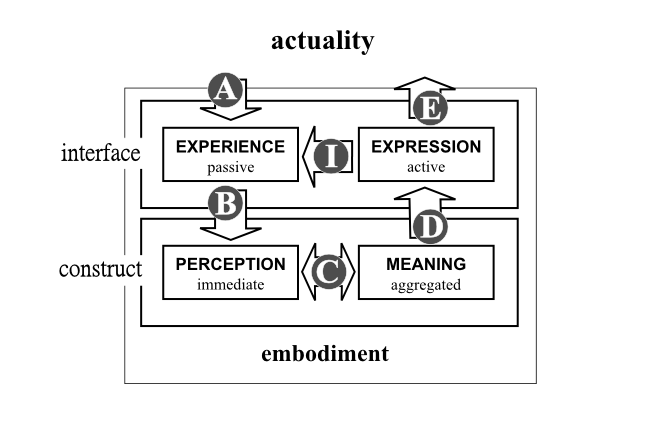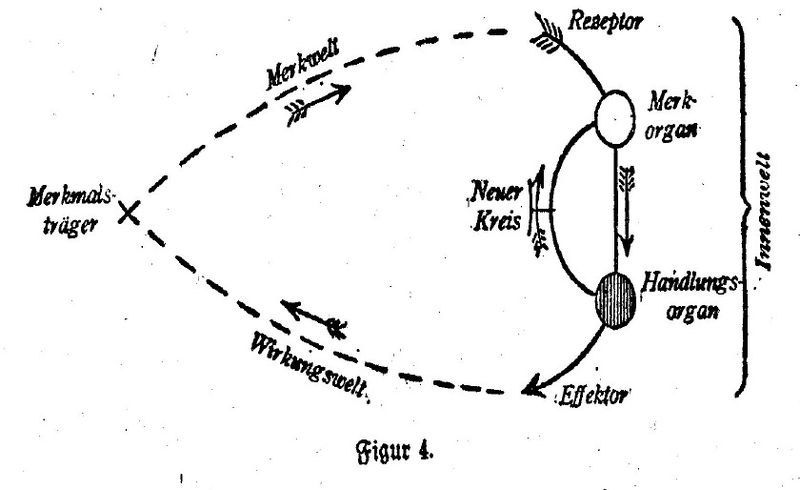expansions
misc.
v.6. Linked to from: A2-Content.php.
meta-expression
in draft
words
Through their use, languages evolve organically and pragmatically. To set out and discuss elementary things then, as in a scientific inquiry, some clarification of their words is necessary. Those here refined from their general use are then emphasized.
Although words naturally refer to our experience and understanding, defining those such as 'intelligence', 'language', 'feeling', and 'perception' exclusively in this way, hobbles their use, and embeds anthropocentrism in our thoughts and conversations.
semiosis
Words in their primary or immediate Signification, stand for nothing, but the Ideas in the Mind of him that uses them. John Locke, 1689.
Any semantic system that is used for communication is a language; Any aspect of a noumenon that in some manner transmits or is perceived as transmitting information is an expression. Both refer to signs, and to semiosis, to sign-action, and therefore to biosemiosis, the recognition, by beings, of noumena, that renders them as signs.
noumena may function as signs of themselves — as being rocks, or holes, or hands, etc., or as exemplars of qualities they are associated with — green, danger, food, etc. They may also signify things distinct from themselves — a sound may be of a river or of a phoneme; marks may signify words, or symbols, like pi; a drawing or photograph may be of a pie, or a pipe.
expression is both an individual and a universal quality; it may be any dynamic or static aspect of a noumenon, of a being or of an inanimate or non-figurative entity; whereas a language is social and specific; a mutually recognized system of expression employed to convey information. beings develop their fluency in both during their ontogeny; from their individuation at 'conception' to their maturation; and then to their eventual death.
biosemiosis
A metalanguage is a language that defines or contextualizes another. meta-expression then is the metalanguage of expression, and defines the process of biosemiosis.

A — Exosemiotic recognition. Reaction to the quality and insistency of the spacio-temporal presence of external phenomena.
B, C, D & I — Endosemiotic reactions; taking place 'internally', for instance, through endocrine, immune, and nervous systems.
E — Exosemiotic expression; a being's embodied reaction to its internal, and external environments.
note: — meta-expression need not have a fixed, one-to-one correlation with its underlying biological constructs.
Biosemiosis is recognition: something present, perceived as the same or similar to something perceived before. endosemiosis is then recognition of self, and exosemiosis recognition of other.
Each being, parallel processing multiple threads of endosemiotic and exosemiotic information, reflects both its inheritance and its experience.
The endocrine apparatus (the hormone system) .. should not be seen as an isolated regulatory system .. but rather as an integral part of both the immune system and the nervous system. Together, .. these endosemiotic tools are collectively responsible for the interaction of the organism with its social and physical world and constitute the fundament out of which so-called psychological reality, if any, of the organism will emerge.
Multicellular beings — all animals and land plants, most fungi, and many algae — have endocrine systems to regulate their physiologies and behaviors. By secreting signaling molecules, called hormones, these systems enable them to 'message' and co-ordinate the various parts of their anatomy.
The signaling molecules of beings that live in both multicellular and unicellular forms — such as social amoebae or slime molds — are called acrasins. These support exosemiotic communication between individuals living as unicellular beings, enabling them to cooperatively respond to environmental change and combine into a single, large cell. They then support the endosemiotic interactions of the 'new' individual being that they form; coordinating its development and enabling it to hunt for food and to reproduce.
In addition to their endocrine systems, multicellular and unicellular beings have either nervous systems, nerve nets, or proto-neuronal systems, that can detect external and internal environmental change.
From bacteria to fish, from slime molds to primates, all cellular beings also possess immune systems. Modern research has shown these systems to be complex, and integrated with other endosemiotic systems in a manner fundamentally similar to our own.
.. contrary to traditional views, jawless vertebrates, protochordates and invertebrates have also evolved sophisticated RAG-independent strategies to effect recognition and facilitate elimination of pathogens, to respond to stress, and to distinguish self from non-self.
It is becoming ever more clear that the co-ordinating, and protective endosemiotic and exosemiotic systems of beings, have evolved together, to form the fundamentally integrated semiotic structures that are found now in virtually all extant cellular phyla.
Numerous studies .. have begun to uncover profound interrelationships .. (that) blur traditional distinctions between adaptive and innate immunity, and emphasize that, throughout evolution, the immune system has used a remarkably extensive variety of solutions to meet fundamentally similar requirements for host protection. ..relentless pressure from genetic variation in pathogens probably drove the evolution of .. innate immune protective molecules towards diversification and, in parallel, towards integration of signalling pathways to regulate cellular responses to external stimulation.
Evolutive science as a whole continues to reveal the holistic nature of life, and to confirm the place of our species in it as a microcosm.
Content of n_Einstein_HumanDelusion.php included in e_Einstein_HumanDelusion.php. NB: Must be used with 'footnotes file' n_Einstein_Translation.php
Human beings are spatially and temporally limited parts of the whole that we call "universe"; yet we experience ourselves and our feelings as separate from the rest, a kind of optical delusion of our consciousness. Albert Einstein, 1950.

